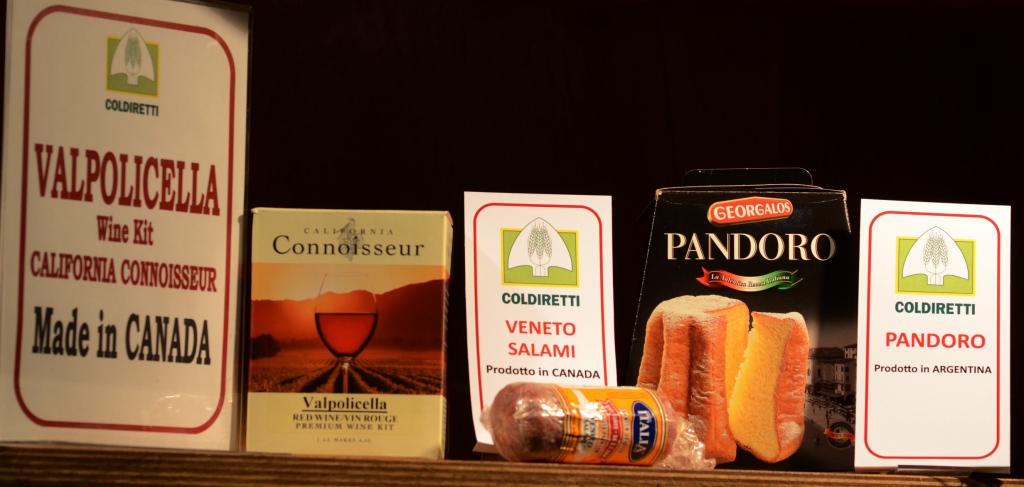Counterfeit and false Made in Italy food oblige Italy to lose more than 60 billion euros which could bring about income and employment. This emerges from a recent study carried out by Coldiretti. The last counterfeit ‘Italian’ alimentary products found in the different continents are evident and curious: Argentinian Pandoro, Made in Canada Venetian Salami, Made in USA Asiago, Kressecco of Germany, a kit for falsifying Parmigiano Reggiano and another one for counterfeiting Valpolicella wine.
 Coldiretti reports that an ‘improvement’ has been made by international piracy concerning alimentary products, affecting the most representative products of Italian identity, with both economic damages and problems concerning our image which are no longer sustainable for Italian agriculture. The name ‘Parmigiano Reggiano’ is still the most copied in the world, with ‘Parmesan’ which is widespread all over the world, from the USA to Canada, from Australia to Japan, but there is also ‘Parmesao’ in Brazil, ‘Regianito’ in Argentina, ‘Reggiano’ and ‘Parmesao’ all over South America, but also ‘Pamesello’ in Belgium. There’s also the opportunity - Coldiretti continues - of buying, in Great Britain, USA, or Australia, a kit for preparing the valuable Italian cheese, of course without giving any importance to the milk which will be used. This is a real fraud, which affects the most prestigious Italian wines, too, such as Valpolicella, that can be falsified with a miraculous kit that promises to obtain it in a few days, with a mixture of powder and must.
Coldiretti reports that an ‘improvement’ has been made by international piracy concerning alimentary products, affecting the most representative products of Italian identity, with both economic damages and problems concerning our image which are no longer sustainable for Italian agriculture. The name ‘Parmigiano Reggiano’ is still the most copied in the world, with ‘Parmesan’ which is widespread all over the world, from the USA to Canada, from Australia to Japan, but there is also ‘Parmesao’ in Brazil, ‘Regianito’ in Argentina, ‘Reggiano’ and ‘Parmesao’ all over South America, but also ‘Pamesello’ in Belgium. There’s also the opportunity - Coldiretti continues - of buying, in Great Britain, USA, or Australia, a kit for preparing the valuable Italian cheese, of course without giving any importance to the milk which will be used. This is a real fraud, which affects the most prestigious Italian wines, too, such as Valpolicella, that can be falsified with a miraculous kit that promises to obtain it in a few days, with a mixture of powder and must.
The range of falsified alimentary products has expanded and now it is possible to find on the markets such cheeses as ‘Pecorino of Friuli’, ‘Romanello’, and Crotonese produced in Canada, or the Gorgonzola sauce made in Germany. Even the falsified Made in Italy cold meats and salami are appreciated in the international markets: it is possible to find made in Romania Sicilian ‘mortadella’, Made in Brazil Salami Milano type, Made in Canada ‘Cacciatore salami’ and ‘Soppressata salami’, ‘Villa Gusto’ cooked ham widespread in Germany.
For first courses, ‘Maccaroni mit Tomatensauce’, ‘Gnocchi Rucola-Parmesan’ produced in Germany, or ‘Palenta’ made in Croatia, maybe with a sauce produced with ‘San Marzano pomidori pelati’ grown in the USA. Oil and wine, too, are part of the most falsified Italian products realized abroad. It is possible to find the ‘Pompeian oil’ of Maryland (United States) as well as the false American ‘Chianti’, but also the German ‘Kressecco’ or ‘Meer-Secco’, which imitate the unattainable ‘prosecco’ and even a Romanian ‘Barbera’, which is not red, but unbelievably white.
The common denominator of these examples of imitation and counterfeiting of Italian food and wine is the opportunity, for a foreign company, of obtaining on its reference market a competitive advantage, unfairly associating to their products the image of Made in Italy, which is appreciated by foreign consumers, with no connection to the Italian production system and so unfairly competing with Italian producers, who always commit themselves to guarantee high quality standards. It is necessary – Coldiretti states - to create an agreement concerning international trade in WTO for the protection of designations from false products, and at the same time explain the question both in Italy and Europe, where all the products should indicate in their labels the origin of alimentary products, as the law, which until now has remained unapplied, requires.
